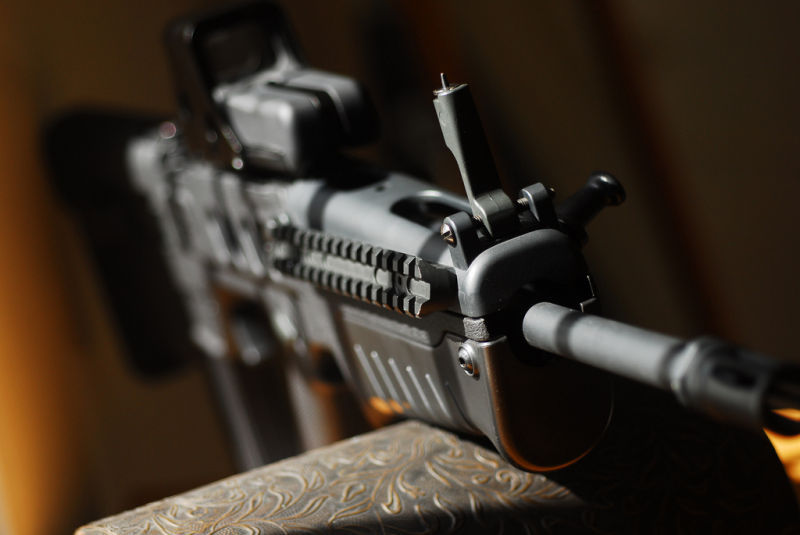Nading: I like my guns … back off
Photo courtesy of Flickr/TimoStudios
Confusing firearm terms has been a primary tactic employed by the Violence Policy Center to achieve their weapon-banning agenda. By using terms such as “assault weapons” in place of “assault rifles,” the group is misleading an uneducated audience into supporting its agenda.
January 30, 2013
I am a democrat, and I like guns.
As a young college student on the verge of uncovering my personal political affiliation, I tentatively but confidently declare myself a democrat.
When it comes to the basics, I find I easily identify myself with those who sit on the left side of political matters. That is, however, until gun control comes up. As a democrat, the notion of restricting “assault weapons” made sense to me. That is, until recently, when I took the time to learn more about the issue.
The term “assault weapon” is heard everywhere today: in the news, from the mouths of government leaders, even by men over their early morning coffee. It has become a term that is presumed to be common knowledge and popular among in everyday conversations. But those who use this term, and others who are on the receiving end of the criticism thrown at these weapons, rarely know what exactly it means for a gun to be identified as an “assault weapon.”
According to research reported in an article published in the American Journal of Criminal Law, the term “assault weapon” was coined by the media in 1989. TIME Magazine used it in an article covering the Stockton Massacre. The term was picked up not only by the public, but our government as well, and has been spreading like wildfire ever since. “Assault weapon” is in fact a fictional term, having no clear-cut definition. It is used today by the government to refer to the firearms used in mass shootings.
If the term is fictional, then how can it be used so widely in conversation today? The answer is confusion. An “assault weapon” is a fictional term, but an “assault rifle” is not, and the two definitions have become so intertwined today it’s turned into a catastrophe of a mess trying to get them sorted out again.
An “assault rifle” refers to a machine gun, an automatic weapon firing multiple shots with a single trigger pull. An “assault weapon,” the term used to refer to semi-automatic firearms legal for civilians to own, can only fire a single shot each time the trigger is pulled. Because of this difference in characteristics, an assault weapon is much less dangerous than an assault rifle.
To put it simply: an “assault rifle” is one that can be seen in popular action movies where a villain is taking aim upon his victims, firing countless shots right in a row without ever taking his finger off the trigger. On the other hand, an “assault weapon” can range from handguns to the old wooden shotgun your grandpa has in his basement, to the revolver handgun John Wayne used to protect the Old West. We use the term “assault weapon” to describe guns used in mass murder shootings, yet none of these guns have ever been used in one. In fact, most hardly ever see more than a couple deer hunting seasons or the inside of a glass display case. These are guns that many see as harmless, yet we still call them “assault weapons” and confuse them with machine guns.
Although all the “assault weapons” mentioned above are generally looked upon as docile firearms, there is another “assault weapon” that keeps the confusion of terms circulating. The AR-15 rifle, the most popular rifle sold in the United States today, has been put under a lot of heat recently. If you aren’t familiar with this gun, one Google search can explain why this firearm is capitalized on by anti-gun coalitions and politicians: because it looks scary.
Compared to your grandpa’s shotgun or John Wayne’s revolver, the AR-15 has a sleek black look to it, giving it a menacing feel. It has advanced attachments that do nothing to make the gun more powerful, but place it under a lot of scrutiny for making it stand out among other “assault weapons.” The AR-15 resembles a machine gun closely, and is therefore commonly mistaken by the public and media as functioning like one as well. Now with the term “assault weapon” attached to the gun, it becomes even more commonly confused with its “assault rifle” cousin.
The talk about stricter gun regulations isn’t a new topic. Since 1988, the Violence Policy Center, a national coalition working to tighten the regulation of firearms in the United States, has been in operation and in opposition against the National Rifle Association. John Sugarmann is the executive director and founder of the Violence Policy Center. Sugarmann is also a brilliant propagandist, and he used his skills to further confuse the public with the terms “assault weapon” and “assault rifle.”
Sugarmann said himself, “Assault weapons — just like armor-piercing bullets, machine guns, and plastic firearms — are a new topic. The weapons’ menacing looks, coupled with the public’s confusion over fully automatic machine guns versus semi-automatic assault weapons can only increase the chance of public support for restrictions on these weapons.”
The man who charged the anti-gun movement years ago said it himself: They are using the confusion of terms and the uneducated public to further increase the support of restricting firearms. It’s important to really listen to what the media and politicians are saying about gun control in America. If we aren’t more careful to properly identify terms being used to inform us, we could end up going down a road that leaves our population defenseless and eating right out of the hands of men like Sugarmann.
——————————————————————————————-
Mackenzie Nading is a junior in political science from Elgin, Iowa.







